
As Ohio State continues to expand its role in the commercialization of research, it is important that we create an environment that facilitates and rewards research creativity and entrepreneurship. To support and stimulate entrepreneurial activity among our researchers, three university-wide awards were presented on November 8, 2011, to our most successful faculty, staff, and student entrepreneurs.
Innovator of the Year: Yasuko Rikihisa
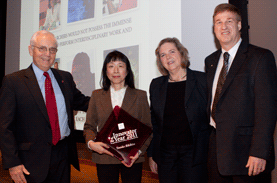
The 2011 recipient of the Innovator of the Year award is Dr. Yasuko Rikihisa, professor in the Department of Veterinary Biosciences in the College of Veterinary Medicine. Dr. Rikihisa’s research career has focused on fundamental understanding and diagnostic platforms for a number of zoonotic tick-borne diseases that infect food and fiber-producing animals, companion animals, and humans. One of these diseases, Ehrlichiosis, has been the focus of much of her research. Ehrlichia – a special type of bacteria that infect and live within the white blood cells of their hosts – can cause serious illness and even death in animals and humans.
In collaboration with the Centers for Disease Control and Prevention, Dr. Rikihisa cultivated canine ehrlichiosis, or E. canis, and cloned and sequenced the immunodominant major outer membrane proteins – information that is critical to the development of effective vaccines. She further demonstrated that these proteins could be used in diagnosing the disease. In 2000, her outer membrane protein patent portfolio was licensed worldwide. The resulting commercial serum test for E. canis remains the standard of care for the annual parasite screening of animals globally. The test is included in the annual health-screening panel for all dogs.
In addition to dogs kept as pets, companion animals for individuals with disabilities have also been shown to be susceptible to tick-borne disease, and in tick-infested areas, there is also a potential for humans to be infected. Dr. Rikihisa also studied anaplasmosis, a tick-borne disease that can infect companion animals. In 2011, her Anaplasma patent portfolio was licensed for companion animals. Commercial products stemming from these licenses are now in development.
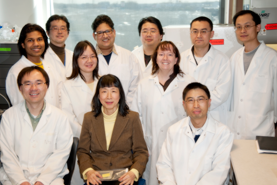
The commercial significance and impact of her work is evident through fees and royalties received from commercial licensing of her discoveries. Revenues from licenses of her intellectual property and assets portfolio have made the College of Veterinary Medicine the leading commercialization-producing college at Ohio State for the past five years.
Since arriving at Ohio State in 1986, Dr. Rikihisa has compiled an impressive record of translational research and commercialization activities. Her Ohio State patent portfolio consists of 11 invention reports, 10 issued U.S. patents, two U.S. patents pending, four issued foreign patents, and two pending foreign patent applications.
As is evidenced by her more than 250 peer-reviewed scientific papers, 24 book chapters, and over $16.8 million in funding from the National Institutes of Health and other sponsors over the last 22 years, Dr. Rikihisa is a scientist whose research spans the entire range of discovery – from basic research to commercialization. Her research efforts continue to translate her basic research findings into new knowledge to help us understand these tick-borne diseases and improve diagnostic products to limit their spread.
Early Career Innovator of the Year: Yebo Li
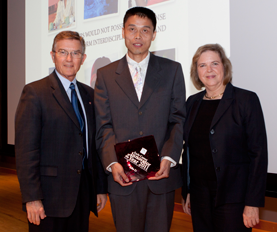
The 2011 Early Career Innovator of the Year is Dr. Yebo Li, assistant professor in the Department of Food, Agricultural, and Biological Engineering at the Ohio Agricultural Research and Development Center (OARDC) and a specialist with Ohio State extension. Dr. Li has developed a successful research and extension program in bioproducts and bioenergy. He is developing a novel renewable source of polyurethane foam for use in a variety of products including automotive seats, headrests, and bumpers; sealants and thermal insulation systems for refrigerators; insulation boards; and packaging materials. The product, known as bio-polylol, is made from crude glycerin, a byproduct of biodiesel production that is considered waste and has little commercial value. When mixed with biomass through a patent-pending process that he developed, the crude glycerin becomes the foundation for making the polyurethane foam. His product is comparable to petroleum-based foam in quality; hower, his product is renewable and is less expensive to produce than petroleum-based foams.
Dr. Li’s technology has been licensed to Poly-Green Technologies, a start-up company, for commercial production. Poly-Green and its collaborators have the potential to displace the petroleum domination of the polyurethane market with a sustainable, environmentally-friendly bio-based polymer material and move Ohio closer to becoming a leader in renewable polyurethane foam production.
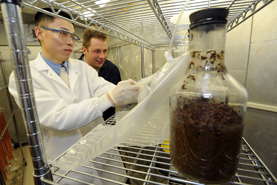
In 2008, Dr. Li began working with quasar energy group on a liquid-phase anaerobic digester. Since that time, he has developed an innovative, patent-pending technology for an integrated anaerobic digestive system, or iADS, that can cost-effectively produce clean energy from both solid and liquid organic wastes through anaerobic digestion. The iADS combines a liquid biodigester, which processes wastes such as manure and sewer sludge, with his “solid state” digestion technology, which allows for the production of methane from varous sources of cellulosic biomass, such as yard trimmings and crop residue. iADS has the potential for significantly enhancing biogas production and making this technology economically feasible for large renewable energy generation in locations that generate a large amount of biomass, like Ohio.
Dr. Li is also working with West Virginia-based Touchstone Research Laboratory in the development of innovative technology for efficiently and profitably growing algae in ponds for production of fuels and other high-value, bio-based products.
Student Innovator of the Year: Christopher Jaworski
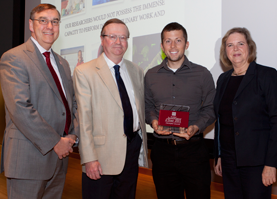
The 2011 Student Innovator of the Year is Christopher Jaworski, a doctoral student in the Department of Mechanical and Aerospace Engineering in the College of Engineering. He is an extraordinarily inventive and talented young researcher who is interested in the study of thermoelectricity – the direct conversion of heat into electrical power – and the study of thermally “pumped” spin polarization in semiconductors. His research has contributed prominently to our fundamental understanding of the thermal properties of matter, and he has applied his discoveries to invent new and practical materials that have potential worldwide impact on energy conservation.
With an interest in thermoelectric energy conversion in vehicles, he designed, constructed, and characterized a bench top thermoelectric waste recovery system as part of his undergraduate honors project. He joined Professor Joseph Hereman’s Thermal Materials Laboratory and played an integral part in the research that detected an effect that converts heat into “spin” in semiconductors. As he pursues his PhD, funded by a U.S. Department of Energy GATE fellowship, his research is focused on cooling materials, but he is also interested in water-splitting and new thermomagnetic spintronics phenomena.

The entrepreneurial focus of his work is aimed at developing new metal alloys with improved thermoelectric efficiency. He has been working closely with ZT Plus, a high-technology start-up company in California, to commercialize new bulk thermoelectric materials for use in automotive air conditioning and waste heat recovery systems. A substantial portion of ZT Plus’ intellectual property portfolio is based on disclosures that he has been an inventor on.
He has co-authored at least 12 invention disclosures, five of which have resulted in patent applications being filed with the U.S. Patent and Trademark Office.
In the future, we can expect him to continue to play a significant role in the movement towards global environmental sustainability.
The Innovator of the Year and the Early Career Innovator of the Year awards recognize Ohio State researchers who are working actively to promote commercialization of university intellectual property, through invention disclosures filed, patents applied for and/or received, technologies licensed, or spin-off companies formed. These activities support economic development in the Central Ohio region, and serve to attract companies that create a base of operations within the state. The creation of separate categories for more established researchers and for early career researchers allows cultivation of an entrepreneurial spirit among all of our investigators.
The Student Innovator of the Year award, established in 2011, recognizes innovation and entrepreneurship among our students that has contributed to the development or commercialization of a new technology.